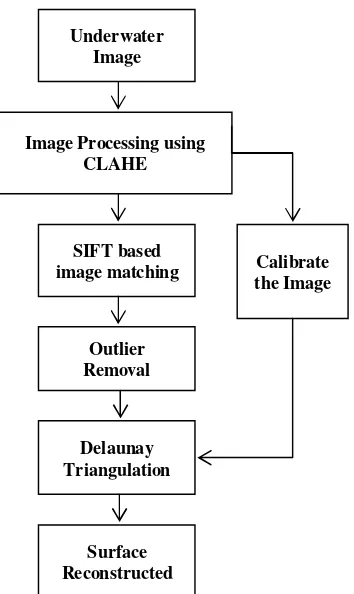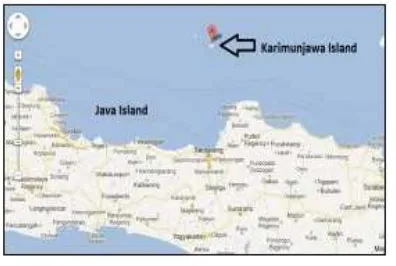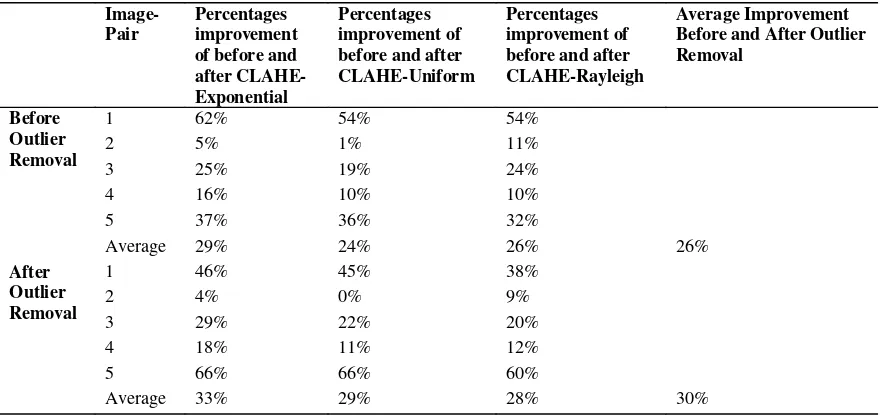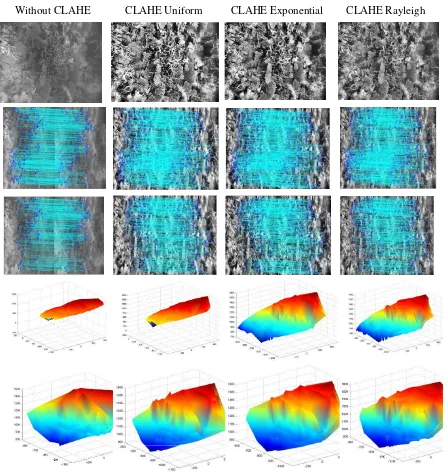1
ENHANCEMENT OF 3D SURFACE RECONSTRUCTION OF
UNDERWATER CORAL REEF BASE ON SIFT IMAGE MATCHING
USING CONTRAST LIMITED ADAPTIVE HISTOGRAM
EQUALIZATION AND OUTLIER REMOVAL
a
Pulung Nurtantio Andono, bRicardus Anggi Pramunendar, cCatur Supriyanto, dGuruh Fajar Shidik,eI Ketut Eddy Purnama, fMochamad Hariadi
a,b,c,d
Faculty of Computer Science, Dian Nuswantoro University Jalan Imam Bonjol, No. 207, Semarang 50131, Indonesia
e,f
Faculty of Industrial Technology, Dept. of Electrical Engineering, ITS, Surabaya, Indonesia Email: [email protected]
Abstrak
Penelitian ini menggambarkan peningkatan kualitas rekonstruksi 3D permukaan terumbu karang bawah laut menggunakan sistem kamera stereo. Algoritma Contrast Limited Adaptive Histogram image Equalization (CLAHE) diusulkan untuk meningkatkan kualitas citra bawah laut tersebut, karena menurunnya kualitas citra bawah laut dapat disebabkan oleh penyerapan dan hamburan sinar matahari. Dalam mengembangkan rekonstruksi 3D permukaan bawah laut, pasangan citra stereo diekstrak secara manual dari rekaman video yang diperoleh, yang kemudian dilakukan proses pencocokan citra stereo menggunakan algoritma SIFT. Kelebihan algoritma SIFT tersebut adalah tahan terhadap perubahan skala, transformasi, dan rotasi dari sepasang citra tersebut. Banyaknya matching point antar 2 citra stereo dijadikan ukuran untuk mengetahui kinerja CLAHE terhadap algoritma SIFT. Hasil penelitian menunjukan bahwa penggunaan CLAHE dan outlier removal mampu meningkatkan jumlah matching point sebesar 56%. Keberhasilan CLAHE tersebut perlu diujikan ke beberapa algoritma matching point yang lain. Perbandingan beberapa algoritma matching point yang menerapkan CLAHE dapat membuktikan bahwa CLAHE sangat cocok dalam meningkatkan kinerja algoritma matching point dan rekonstruksi permukaan 3D citra bawah laut.
Kata kunci: Rekonstruksi 3D, Citra Bawah Laut, SIFT, CLAHE.
Abstract
This research describes an enhancement of 3D Reconstruction coral reef images using stereo camera system. Contrast Limited Adaptive Histogram image Equalization (CLAHE) algorithm was proposed to enhance the image quality in preprocessing area, since the quality of underwater images degrades by the absorption and scattering of light. To develop a 3D-representation of the seafloor, image-pairs were first extracted from the video footage manually, then corresponding points are automatically extracted from the stereo-pairs by SIFT matching algorithm, which is invariant to scale, translation, and rotation. Number of matching points is used to evaluate the performance of SIFT with and without CLAHE. As a result, the promising techniques provides better 3D reconstruction details of coral reef imagesin total, the combination of CLAHE and outlier removal performs the enhancement for 56%. For further, CLAHE need to be performed to other image matching techniques. The comparison of different image matching techniques with and without CLAHE can prove that CLAHE is appropriate as image enhancement method for image matching and 3D surface reconstruction.
INTRODUCTION
Underwater ecosystems have become an international attention since its effect on environmental changes that includes the evolution of coral reef environments. Indonesia as part of the coral-reef triangle has 18% of coral reefs around the world and placed as one of the countries where coral reefs are most threatened according to reefs a risk [1]. The survey result of the Indonesian Institute of Science [2] states that only 5.23% of coral reefs in Indonesia are in good condition.
With the advances in underwater robotics, it become a cost-effective technology to monitoring critical and endangered benthic cover such as coral reefs environment that caused by various sources of hazards [3]. In the field of ocean study, 3D reconstruction and measurement of underwater images can be generated by 3D visual observations [4]. Reconstruction of 3D structures is useful in underwater applications. 3D mosaicking is one important tool for exploration, visualization, underwater navigation, and can estimate the size of the objects of interest such as organisms and structures [5].
However, underwater images are suffering from image quality due to the absorption and scattering of light as it reaches the seafloor[6]. This condition gives problem in 3D reconstruction process, since some pixels become brighter than others (shimmering) and colors degrade as light at longer wavelengths (green, red) is largely filtered in the first 4 meters of the water column [7]. Figure 1 schematically shows the main process of light interactions in the sallow seas.
Figure 1.Water surface effects[7].
Several methods have been proposed to enhance the quality of underwater imagery in [6] proposed underwater image enhancement using an integrated color model. Iqbal et al[8] also proposed an Unsupervised Color Correction Method (UCM) approach for underwater image enhancement. The proposed method has produced better results compared to the existing method. In [9], comparing several filter that can be used to improve the quality of underwater image. Hogue et al.[10] developed a stereo vision-inertial sensing device to reconstruct complex 3D structures in both the aquatic and terrestrial domains. Other enhancement methods that used gray scale manipulation, filtering and Histogram Equalization (HE) could be seen at [11-14].
Histogram equalization is one of the popular techniques for contrast enhancement because this method is simple and effective [11]. Contrast Limited Adaptive Histogram Equalization (CLAHE) has becoming successful histogram equalization method for low contrast image enhancement [15]. The performance of Contrast Limited Adaptive Histogram Equalization (CLAHE), contrast stretching, and histogram equalization method have been compared and analyzed by Singh et al.[16], which revealed that CLAHE method improved image quality efficiently.
The importance thing of image quality for improving the number image matching, also resulting many researcher to concern in this field such as in [17-22]. Several researchers have conducted 3D surface reconstruction for underwater objects. In [23] proposed a novel technique to reconstruct 3D surface of an underwater object using stereo images. They focused on degradation of quality of underwater images, such as non-uniform illumination of light on the surface of objects, scattering and absorption effects.
To enhance their image quality, homomorphic, wavelet denoising and anisotropic filtering sequentially are performed. Triangulation was used to generate depth map of 3D surface underwater. However, Mahiddine et. al.[17] stated that homomorphic filter leads to poor the quality of 3D surface reconstruction. To overcome this limitation, the success of CLAHE using Rayleigh distribution in our previous research [24] is proposed to enhance the quality of 3D surface reconstruction of underwater images. CLAHE
Diffusion
Crinkle Pattern 1-4m Rayleigh scattering
using Rayleigh distribution successfully improved the number of image matching performed by SIFT. CLAHE with Rayleigh distribution registration success of SIFT increased by 41% compared to the contrast stretching enhancement [24].
Due to the information above, there has been no any specific research that enhances the image quality to improve underwater 3D reconstruction with CLAHE. Therefore, this paper focuses on 3D reconstruction underwater seafloor improvement using CLAHE with triangulation and SIFT image matching where in the images are gathered from stereo camera system.
The remainder of this paper is organized as follows. Section II presented the theoretical background. Section III explains our method for 3D surface reconstruction. Section IV demonstrates the result of 3D surface reconstruction with/without outlier removal. The conclusion and road ahead are in final the images in this plane are always in focus and size of the image relative to the actual size of the object.
Pinhole Camera model consists of image plane and the center of projection. Image plane is the place where the image is reflected, while the central projection is the place where the rays converge. The distance between the centers of projection is called the focal length ( ).
Figure 2. Pinhole Camera Model.
Figure 2 shows the model of pinhole camera. If is the observed point, is projected into the image plane by drawing a line from to the center of projection. The point of intersection with the line of the image plane produces which is the projection of point to the image plane.
Camera Calibration
Sample image of the dataset needs to be selected for calibrating the camera. Camera calibration has been performed using MATLAB Calibration Toolbox. Camera calibration was used to obtain intrinsic and extrinsic parameter of the camera. Intrinsic parameter consists of focal length, principle point, pixel size, and distortion coefficient. Meanwhile, extrinsic parameter describes the position of the camera in the world coordinate. Intrinsic and extrinsic matrix is shown in Equation (1) and Equation (2).
s.p A.[R|t].P (1) coordinates in the world coordinate space. Figure 3 shows camera coordinate system coincides with the
world coordinate system.
f
Contrast Limited Adaptive Histogram Equalization
image by utilizing a parameter limit value of histogram in order to handle over brightness and contrast on an image [25].
CLAHE works by divide an image into several non-overlapping regions. Then for each region, histogram is calculated. Next, histogram is clipped by a desired limit for contrast expansion. The distribution of the pixel for the histogram can be transform into uniform, exponential, and Rayleigh distribution [25].
CLAHE limits the maximum value of histogram. The clip limit can be obtained by Equation (3).
max
1 ( 1
100 M
S
N (3)
Where is clip limit factor, M region size,
Nis grayscale value. The maximum clip limit is
obtained for =100. The illustration of clipped limit is shown in figure 4.
Figure 4. Histogram (a) before and (b) after clipping histogram [26].
SIFT Algorithm
Our study utilize SIFT based image matching to obtain the matching point in image pair. These matching points are useful to reconstruct 3D model. SIFT method was developed by Lowe [27]. The method includes fourphase:
Scale-space extreme detection
The first stage in the process of computing is to identify all potential key point on all scales. Scale an image space is defined as a function of ( , , ) which is the product of convolution between the Gaussian kernel ( , , ) with the image ( , ). To find features on the imagery used operators Difference of Gaussian (DoG) by compiling octave image pyramid with different scales.
Keypoint localization
From the keypoint candidates obtained from a scale-space extrema detection, high stability keypoint will be selected. The emergence of feature-level stability is based on the features of each octave.
Orientation assignment
Orientation of the keypoint based on local gradient direction of each image. Any operation performed on the image based on the direction, orientation and location of the keypoint.
Keypoint descriptor
Local gradient image is computed at each scale region around the keypoint. In that situation, then transformed to local distortions and illumination changes in the area around the keypoint.
SIFT used Gaussian to develop scale space therefore it can be called Gaussian scale space. Next stage is compute the Difference of Gaussian Scale (DoG) as in equation (4).
( , , )= ( , , ) ( , , )(4)
Where ( , , ) is the convolution of the original image ( , ) with Gaussian filter ( , , ) on the scale and ( , , ) is the convolution of original image ( , ) with Gaussian filter ( , , ) on scale , k 2
Delaunay Triangulation
Triangulation is the process of finding coordinates and distance of a point by measuring angles between that point and two other reference points of known position and the distance between them. Triangulation is
Pixel number
Actual clipping
level
Gray level (b)
Pixel numbe
Nominal clipping level
used in many fields, such as mapping, navigation, metrology, and astrometry. 3D surface reconstruction of seafloor mapping can be generated by using triangulation formulas when the coordinates and distance of the points is known. Set of features that have been reconstructed is called 3D point. Figure 5 is the visualization of Delaunay triangulation. There is no point of in its interior of the circumcircles of a triangle in Delaunay triangulation [28].
a. b. c.
Figure 5. (a) Illegal and (b) (c) Legal Delaunay Triangulation
Outlier Removal
Removing the outlier would reduce wrong correspondence from image registration which lead to more robust 3D pattern of the coral reef. Average distance between pair of matching SIFT points is used to eliminate outliers. Let us denote N the number of matching SIFT points, d is the distance between a pair of matching
SIFT points, and i is the index of current
matching SIFT points. The average distance of matching SIFT points calculated as in outlier if the distance of matching SIFT point is higher than the average distance of matching SIFT pointsdi .
Our 3D reconstruction is based on our two previous works: 3D reconstruction method of coral reefs using low-cost underwater cameras [29] and underwater image enhancement using adaptive filtering for enhanced SIFT-based image matching [24]. Figure 6 represents our proposed model of 3D surface reconstruction with an underwater image enhancement. This study evaluates our previous underwater image
enhancement for 3D reconstruction of sea floor mapping.
Figure 6. Proposed Model of 3D Surface Reconstruction.
Figure 7. Camera Calibration Using Checkerboard.
Our work is defined as follows:
1. Image Processing.
Our study selects underwater image from stereo image camera which stereo images are suitable for 3D reconstruction. This is performed to get more correspondence points between stereo images to build more accurate 3D reconstruction. CLAHE is performed to enhance the quality of image. Our study evaluates three types of
CLAHE distribution: uniform,
exponential, and Rayleigh distribution.
X Y
O
100 200 300 400 500 600 50
100 200 300 400 500 600 50
2. Camera Calibration.
MATLAB Calibration Toolbox is performed to obtain intrinsic and extrinsic parameters. This paper used chessboard 17.5×22.5 cm to perform camera calibration. Size of square in chessboard is 2.5×2.5 cm, as shown in Figure 7.
3. SIFT Key points Detection.
SIFT algorithm is employed to perform image matching.
4. Outlier Removal.
Averaging the distance of match point between left and right image is the simplest way to detect the outlier of image matching. Our study remove the match point if the distance is higher than the average distance of match point.
5. 3D Reconstruction using Triangulation. Employing correspondence paired points and internal, external parameter that calculated with triangulation to produced 3D points.
6. Surface reconstruction using Delaunay Triangulation.
Reconstructed 3D coordinates points that obtained by triangulation formulas. The number of 3D points is processed with Delaunay triangulation algorithm to produce surface reconstruction.
RESULT AND DISCUSSION
Data Acquisition
In this study, we use camera Olympus µ Tough-8010 cameras and resolution of 1280 × 720 pixels. Our data was collected at Karimunjawa Island Central Java Indonesia.
Karimunjawa is a National Marine Park declared as a Natural Conservation Area by Decree of the Minister of Forestry, located at 5°49’-5°57’ South Latitude and 110°04'-110°40' East Longitude in the Java Sea, north of Java, Indonesia, as seen in Figure 8.We explore the underwater coral reef images in 4-5 meter deep.
Analysis
Our quantitative analysis is reported in Table 1. This table shows a significant difference with respect to the number of matching points. CLAHE with different point distributions (i.e. uniform, exponential and Rayleigh)
successfully improves the number of image matching by average of 26% and 30% before and after outlier removal respectively. Detailed percentages improvement is shown in Table 2.
Figure 11 shows 3D image reconstruction developed from the sample stereo image-pair in Figure 9. In this study, we find that CLAHE and outlier removal have great influence on the 3D surface reconstruction. The accuracy of 3D surface reconstruction is greatly improved when more number of matching points is obtained. Our proposed approach produces promising result because the 3D representation of surface produce by CLAHE with Rayleigh and exponential distribution is more realistic appearance compared to before image enhancement. The 3D structure must be improved when many number of matching points is obtained. The superiority of CLAHE is shown in figure 10, which improves the number of image matching of poor original image.
Figure 8. Karimunjawa Island.
Figure 9. Sample of Stereo Image-Pair from left and Right Camera.
Table 1. Performance of SIFT with and without CLAHE before and after Outlier Removal.
Image-pair
without CLAHE CLAHE Exponential CLAHE Uniform CLAHE Rayleigh Before
Table 2. Percentages Improvement of SIFT with and without CLAHE before and after Outlier Removal. Before and After Outlier Removal
Table 1 demonstrates that CLAHE-Exponential is much better than CLAHE with other distributions. Anyhow, in the case of image-pair no. 2, CLAHE-Rayleigh distribution is better than CLAHE-exponential or uniform, due to the majority of its data points are on the left side and center of the graph as seen in Table 3.
CONCLUSION
In this study, underwater image enhancement for 3D surface reconstruction of coral reef image. High number of matching points are the results of image enhancement using CLAHE and furthermore by outlier removal. By employing CLAHE in average the image matching point increasing for 26%, while by adding outlier removal, the image matching point increasing for 30%. Therefore in total, the combination of CLAHE and outlier removal performs the enhancement for 56%.
Table 3. Histogram of Original Image.
No. Image-Pair Histogram
1
2
3
4
Increasing the number of matching point improve the quality of 3D surface reconstruction of underwater images.
For the road ahead, CLAHE need to be performed to other image matching techniques.
The comparison of different image matching techniques with and without CLAHE can prove that CLAHE is appropriate as image enhancement method for image matching and 3D surface reconstruction.
Without CLAHE CLAHE Uniform CLAHE Exponential CLAHE Rayleigh
REFERENCES
[1] P. J. Besl and N. D. McKay, "A Method for Registration Of 3-D Shapes," IEEE Transactions on Pattern Analysis and
Machine Intelligence, vol. 14, pp.
239-256, 1992.
[2] Y. Chen and G. Medioni, "Object Modeling by Registration of Multiple Range Images," in Proceedings of 1991
IEEE International Conference on
Robotics and Automation, pp. 2724-2729,
1991.
[3] R. Bergevin, M. Soucy, H. Gagnon, and D. Laurendeau, "Towards a General Multi-View Registration Technique," IEEE Transactions on Pattern Analysis and
Machine Intelligence, vol. 18, pp.
540-547, 1996.
[4] G. Blais and M. D. Levine, "Registering Multiview Range Data to Create 3D Computer Objects," IEEE Transactions on
Pattern Analysis and Machine
Intelligence, vol. 17, pp. 820-824, 1995.
[5] S.Y. Park and M. Subbarao, "An Accurate and Fast Point-To-Plane Registration Technique," Pattern Recognition Letters, vol. 24, pp. 2967-2976, 2003
[6] A. E. Johnson and K. Sing Bing, "Registration and integration of textured 3-D data," in Proceedings of International Angular-Invariant Feature, "
Neurocomputing, vol. 72, pp. 3839-3844,
2009.
[8] C. Torre-Ferrero, J. R. Llata, S. Robla, and E. G. Sarabia, "A Similarity Measure For 3D Rigid Registration of Point Clouds using Image-Based Descriptors with Low Overlap", in Proceedings of IEEE 12th International Conference on Computer
Vision Workshops (ICCV Workshops), pp.
71-78, 2009.
[9] Y. Liu, "Constraints for Closest Point Finding," Pattern Recogn. Lett., vol. 29, pp. 841-851, 2008.
[10]J. Bernal, R. Flowers-Cano, and A. Carbajal-Dominguez, “Exact Calculation Of The Number of Degrees of Freedom of A Rigid Body Composed of n Particles,”
Revista mexicana de física,vol. 55, pp.
191–195, 2009
[11]K. S. Arun, T. S. Huang, and S. D. Blostein, "Least-Squares Fitting of Two 3-D Point Sets," IEEE Transactions on
Pattern Analysis and Machine
Intelligence, vol. PAMI-9, pp. 698-700,
1987.
[12]G. Agam and T. Xiaojing, "A Sampling Framework For Accurate Curvature Estimation in Discrete Surfaces," IEEE
Transactions on Visualization and
Computer Graphics, vol. 11, pp. 573-583,
2005.
[13]C. Doutre and P. Nasiopoulos, "Correcting Sharpness Variations in Stereo Image Pairs", in Proceedings of Conference for
Visual Media Production (CVMP '09) , pp.
45-51, 2009.
[14]K. Taekyung and P. Joonki, "Adaptive Contrast Enhancement Using Gain-Controllable Clipped Histogram Equalization," IEEE Transactions on
Consumer Electronics, vol. 54, pp.
1803-1810, 2008.
[15]R. K. Rai, P. Gour, and B. Singh, “Underwater Image Segmentation using CLAHE Enhancement and Thresholding,”
International Journal of Emerging
Technology and Advanced Engineering,
vol. 2, pp.118-123, 2012.
[16]B. Singh, R. S. Mishra, and P. Gour, “Analysis of Contrast Enhancement Techniques for Underwater Image,”
International Journal of Computer
Technology and Electronics Engineering,
vol. 1, pp. 190-194, 2011.
Graphics, Visualization and Computer
Vision (WSCG 2012), 2012.
[18]Y. Bastanlar, A. Temizel, and Y. Yardmc, "Improved SIFT Matching for Image Pairs With Scale Difference," Electronics
Letters, vol. 46, pp. 346-348, 2010.
[19]O. Pele and M. Werman, "A Linear Time Histogram Metric for Improved SIFT Matching," in Proceedings of the 10th
European Conference on Computer
Vision: Part III, Marseille, France, 2008.
[20]P. Moreno, A. Bernardino, and J. Santos-Victor, "Improving the SIFT descriptor with smooth derivative filters," Pattern
Recognition Letters, vol. 30, pp. 18-26,
2009.
[21]D.T. Lin and C. H. Hsu, "Improving the Efficiency and Accuracy of SIFT Image Matching," in Proceedings of the 2nd International Congress on Computer
Applications and Computational Science,
vol. 145, F. L. Gaol and Q. V. Nguyen, Eds., ed: Springer Berlin Heidelberg, pp. 227-233, 2012.
[22] -Durrant,
and A. Gräser, "Improved SIFT-features Matching For Object Recognition," in
Proceedings of the 2008 international conference on Visions of Computer Science: BCS International Academic
Conference, London, UK, 2008.
[23]C. J. Prabhakar and K. P. U. Praveen,“3D Surface Reconstruction of Underwater Objects”, in IJCA Proceedings on
National Conferecne on Advanced
Computing and Communications, vol.
NCACC, pp. 31-37, 2012.
[24]P. N. Andono, I. K. E. Purnama, and M. Hariadi, “Underwater Image Enhancement using Adaptive Filtering for Enhanced SIFT-Based Image Matching,” Journal of Theoretical and Applied Information
Technology, vol. 51, pp. 392-399, 2013.
[25]Suprijanto, Gianto, E. Juliastuti, Azhari, and L. Epsilawati, "Image contrast enhancement for film-based dental panoramic radiography," in Proceedings of 2012 International Conference on System
Engineering and Technology (ICSET), pp.
1-5, 2012.
[26]S. M. Pizer, E. P. Amburn, J. D. Austin, R. Cromartie, A. Geselowitz, T. Greer, B. T. H. Romeny, and J. B. Zimmerman, "Adaptive histogram equalization and its variations", Comput. Vision Graph. Image
Process, vol. 39, pp. 355-368, 1987.
[27]D. G. Lowe, "Distinctive Image Features from Scale-Invariant Keypoints", Int. J.
Comput. Vision, vol. 60, pp. 91-110, 2004.
[28]Ø. Hjelle and M. Dæhlen, Triangulations and Applications: Springer London, Limited, 2006.
[29]P. N. Andono, E. M. Yuniarno, M. Hariadi, and V. Venus, "3D Reconstruction of Under Water Coral Reef Images Using Low Cost Multi-View Cameras," in Proceedings of International Conference on of Multimedia Computing
![Figure 1.Water surface effects[7].](https://thumb-ap.123doks.com/thumbv2/123dok/4036391.1979811/2.595.66.260.587.714/figure-water-surface-effects.webp)
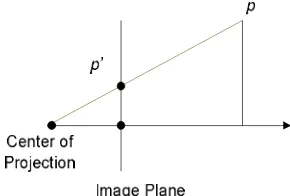
![Figure 4. Histogram (a) before and (b) after clipping histogram [26].](https://thumb-ap.123doks.com/thumbv2/123dok/4036391.1979811/4.595.75.243.383.673/figure-histogram-a-before-and-after-clipping-histogram.webp)
